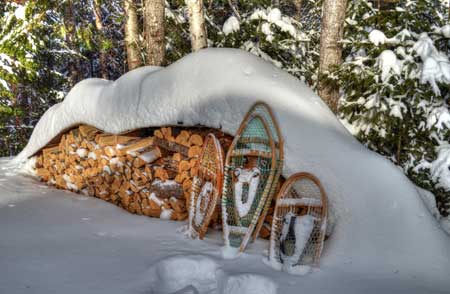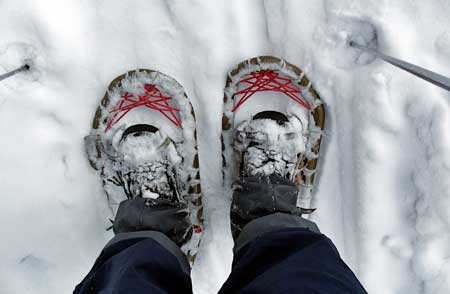
Snowshoes are a traditional means of walking on snowy terrain. When the snow is soft, they allow for efficient movement; without them, we would sink at every step, expending an enormous amount of energy. Although snowshoeing is usually slower than on skis, snowshoes make it possible to move through bushy or rocky terrain where skis do not do as well.
Let's not think that putting a wide platform on your feet to avoid sinking into the snow is a modern invention; some authors maintain that the appearance of snowshoes could date back to the Neolithic period. The traditional snowshoes, of North American origin, made of wood and leather, which allowed the indigenous population to move across the great plains, are the inspiration for today's snowshoes, which have a much more sporty approach.
Currently they are made of plastic or aluminum alloys, less elongated and narrower, with articulated bindings on the feet. Also some of them have small spikes to bite the snow as well as sharper edges, with all this we gain stability and security being its evolution very evident.
There are different types of snowshoes depending on the use we are going to make of them
They are used for walking on large plains where large amounts of snow accumulate. They lack traction systems and do not usually have a lift or heel lock. They can be dangerous and uncomfortable in hard snow.
They are the majority of those that we find on the market, they are versatile and allow progression in various types of terrain. They provide traction systems, heel lift and locking, claws...

They are used for running or Nordic walking. Most of them require footwear for automatic bindings, do not incorporate lift, favor maximum rotation and the front claw is smaller than the mountain ones. Not recommended outside of competition.
We could also make a subcategory according to the choice of fastener in each case

Most models incorporate it, but it has the disadvantage that they need more constant adjustments and that with intense cold they freeze. To close the straps can be double washers or micrometric or ratchet closure that gives us more support on the foot, better fit and does not freeze, and can be adjusted with gloves.
Handling system, comfortable and fast, consisting of a metal toe cap and a rear clamp. This binding requires rigid crampon boots with front and rear flange, if you do not use these boots the racquet can come loose.
This system allows to eliminate the fastening plate, the sole does this function, fast and perfect fastening that forms a link between boot and racquet. It requires the same footwear as the automatic one.
When we see a mountain racquet and look at it in its natural position we can see several well-defined parts such as the front tip or spatula, the shaft, the body or hull, the binding, the size regulator, the heel blocker and the riser. On the other side we can distinguish the tail, the profile, the metal tips and the front nail. When we are going to choose our snowshoe we must take into account several concepts so that our choice is as accurate as possible. The first thing we should ask ourselves what we are going to use it for and the terrain where we are going to move. Then we will look at the type of binding we need depending on the footwear to be used.

The third and very important point is to take into account our weight with the equipment we are going to carry because if we get confused we will sink more than desired in the snow or we will be forced to walk with our legs wide open. The same model of snowshoes can have several sizes, depending on the weight of the user who is going to use it, although there are also models that allow us to increase the width or length of the snowshoe. Seeing its characteristics or asking the seller can save us from making the wrong choice. It would not be superfluous to check the weight of the snowshoe itself because sometimes you have to carry them in your backpack. The fourth and last point would be to think about the possibility of spare parts, since the metal tips, the rise, the size regulator, etc... are usually in high demand.
We have to take into account certain guidelines at the time of snowshoeing, which are added to those that we already have to observe before venturing into any activity.
Check ties from time to time as they may tend to loosen.
The heel should be free and only be locked when descending steep slopes, flanking or overcoming obstacles and for transport.
We will use two hiking poles as they will give us security and stability.
On steep slopes, hard snow and snowshoes are not usually a good combination, and can lead to very dangerous situations. Descents on slopes with ice or hard snow cannot be done with snowshoes, as they are not a substitute for crampons and ice axes. If the state of the snow is suitable for descending with our snowshoes, we must make sure that it does not tilt excessively and control our speed of descent.

We will not face a slope if we are not sure that it meets the requirements to climb it with maximum safety and be able to complete it, turning around with snowshoes can be a dangerous maneuver.
Flanking is another dangerous maneuver to perform with snowshoes, if it occurs it means that we have not chosen well the track of our route and then we will have to look for another more suitable tracing or turn around and change the activity.
Enjoying an activity with snowshoes is very comforting either in a group or with the family, since it does not require an extremely refined technique to have a good time, but we must not forget that we are in a winter environment and we must take the necessary precautions for an outing of this kind. Preparing the route, checking the weather and the risk of avalanches, as well as choosing the right route for both our possibilities and those of the people accompanying us, wearing the right clothes and footwear, among other things, are essential for our safety.
We would be grateful if you could write to us to inform us of a ny erroneous or outdated information you have found, or simply to let us know what you think at Thank you very much.
ATTENTION the prices or price ranges that are published are offered for information purposes only, SENDITUR does not guarantee in any case the accuracy of such information. Likewise, the images do not correspond to the model and/or product proposed, and are offered as an illustration of the corresponding explanation. These recommendations are offered for information purposes only, trying to provide useful information to users, in no case do they imply that Senditur recommends or advises against a particular product or service. Legal Conditions. By purchasing any product through these links you contribute to the maintenance and improvement of this website, in no case you will be overpriced on the product or products you buy. Thank you very much for your contribution.